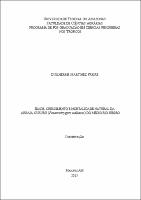| ???jsp.display-item.social.title??? |


|
Please use this identifier to cite or link to this item:
https://tede.ufam.edu.br/handle/tede/6858| ???metadata.dc.type???: | Dissertação |
| Title: | Idade, crescimento e mortalidade natural da arraia-cururu (Potamotrygon wallacei) do médio Rio Negro |
| Other Titles: | Age, growth and mortality of cururu stingray (Potamotrygon wallacei) |
| ???metadata.dc.creator???: | Martinez Freire, Guilherme  |
| ???metadata.dc.contributor.advisor1???: | Duncan, Wallice Luiz Paxiúba |
| First advisor-co: | Góes de Araújo, Maria Lúcia |
| ???metadata.dc.contributor.referee1???: | Pereira, Henrique dos Santos |
| ???metadata.dc.contributor.referee2???: | Marcon, Jaydione Luiz |
| ???metadata.dc.contributor.referee3???: | Catarino, Michel Fabiano |
| ???metadata.dc.description.resumo???: | O estudo de parâmetros de crescimento em elasmobrânquios é de grande importância, principalmente devido às características intrínsecas de crescimento lento, maturação tardia e baixo potencial reprodutivo. Apesar de grande parte dos elasmobrânquios exibirem essas características, algumas espécies de arraias marinhas apresentam crescimento rápido quando comparadas com grandes tubarões. As arraias da família Potamotrygonidae são as únicas totalmente adaptadas ao ambiente dulcícola. Algumas espécies são legalmente exploradas pela pesca ornamental, porém, os pontos de referência do manejo destas espécies não têm conotação biológica e são fortemente influenciados pela demanda. O nosso objetivo foi estimar a taxa de crescimento e mortalidade da arraia cururu (Potamotrygon wallacei) na região do Médio Rio Negro. Para estimar os parâmetros da curva de crescimento realizamos contagem de bandas de crescimento em vértebras. Para aumentar o número de dados, foi realizado o retrocálculo para ajustar a curva de von Bertalanffy. Os parâmetros estimados foram usados para estimar a taxa de mortalidade natural pelo método de Jensen e pelo método de Pauly. A taxa de crescimento (K) foi estimada em 0.26 ano -1 , o tamanho máximo teórico estimado foi de 19,8 cm, o tempo quando o tamanho da arraia é igual a zero (t 0 ) foi estimado em -1,4 anos e o tamanho ao nascer estimado em 9,6 cm. A longevidade foi estimada entre 7,0 anos e 13,4 anos pelos métodos de Ricker e Fabens, respectivamente. A mortalidade estimada pelos dois métodos foi de 0,75 ano -1 e 0,42 ano -1 . O tamanho explorado pela pesca ornamental (14 cm) representa indivíduos de dois anos, representando os poucos sobreviventes que passaram pela alta taxa de mortalidade nos dois primeiros anos. A explotação da coorte por um ano indica um limite de captura de até 12 cm, incidindo a pesca na faixa etária de maior mortalidade natural minimizando o efeito da pesca. |
| Abstract: | The study of growth parameters in elasmobranch is of great importance, mainly due to intrinsic characteristics such as slow growth, late maturation and low reproductive potential. While much of elasmobranch exhibit these characteristics, some species of marine rays show fast growth rate when compared to large sharks. The Potamotrygonidae stingrays family are the only fully adapted to the freshwater environment. Some species are legally exploited for ornamental fish; however, the management of the reference points of these species has no biological connotation and are strongly biased by the demand. Our objective was to estimate the growth rate and mortality of stingray cururu (Potamotrygon wallacei) in the Middle Rio Negro region. To estimate growth curve parameters, we realize growth bands count. To increase the number of data, the original data was retrocalculated to adjust the von Bertalanffy curve. The estimated parameters were used to estimate the natural mortality rate by Jensen and Pauly methods. The growth rate (K) was estimated at 0.26 y -1 , maximum theoretical size estimated 19.8 cm, the time when the size of the ray is zero (t0) is estimated at -1.4 years and size at birth estimated at 9.6 cm. Longevity was estimated between 7 years and 13 years and four months by Ricker and Fabens methods. Estimated mortality by two methods was 0.75 yr -1 and 0.42 yr -1 . The size exploited by ornamental fish (14 cm) represents individuals two years, accounting for the few survivors who went through the high mortality rate of the first two years. The exploitation of the cohort for one year indicates a catch limit of up to 12 cm, covering fishing in the age range of most natural mortality, minimizing the effect of fishing. |
| Keywords: | Arraia Potamotrygonidae |
| ???metadata.dc.subject.cnpq???: | CIÊNCIAS AGRÁRIAS: RECURSOS PESQUEIROS E ENGENHARIA DE PESCA: RECURSOS PESQUEIROS DE ÁGUAS INTERIORES: AVALIAÇÃO DE ESTOQUES PESQUEIROS DE ÁGUAS INTERIORES |
| Language: | por |
| ???metadata.dc.publisher.country???: | Brasil |
| Publisher: | Universidade Federal do Amazonas |
| ???metadata.dc.publisher.initials???: | UFAM |
| ???metadata.dc.publisher.department???: | Faculdade de Ciências Agrárias |
| ???metadata.dc.publisher.program???: | Programa de Pós-graduação em Ciências Pesqueiras nos Trópicos |
| Citation: | FREIRE, Guilherme Martinez. Idade, crescimento e mortalidade natural da arraia-cururu (Potamotrygon wallacei) do médio Rio Negro. 2015. 33 f. Dissertação (Mestrado em Ciências Pesqueiras nos Trópicos), Universidade Federal do Amazonas, Manaus, 2015. |
| ???metadata.dc.rights???: | Acesso Aberto |
| URI: | https://tede.ufam.edu.br/handle/tede/6858 |
| Issue Date: | 10-Nov-2015 |
| Appears in Collections: | Mestrado em Ciências Pesqueiras nos Trópicos |
Files in This Item:
| File | Description | Size | Format | |
|---|---|---|---|---|
| Dissertação_GuilhermeFreire_PPGCIPET.pdf | Dissertação | 1.14 MB | Adobe PDF |  Download/Open Preview |
Items in DSpace are protected by copyright, with all rights reserved, unless otherwise indicated.




